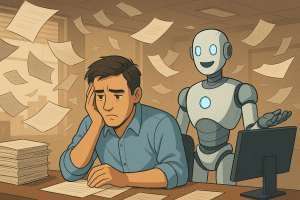Gen AI Might Be Quietly Killing Your Team’s Motivation
May 14, 2025
As mortgage executives explore the transformative potential of generative AI (gen AI) to drive efficiency and reduce cost-to-close, a new insight from behavioral science should give pause: while gen AI undeniably boosts productivity, it may simultaneously erode employee motivation.
A recent study published by Harvard Business Review—spanning over 3,500 professionals—found that while gen AI improves task performance, it can reduce employees’ intrinsic motivation and increase boredom when they switch to tasks that don’t use AI.
Key Findings Mortgage Leaders Should Note
- Performance vs. Engagement: Gen AI makes tasks like writing emails, drafting reviews, or summarizing data faster and often better. However, after completing AI-assisted tasks, employees reported an 11% drop in motivation and a 20% spike in boredom when switching to solo work.
- Loss of Control Undermines Drive: When gen AI takes over complex, fulfilling aspects of a task, workers can feel detached—less like authors of their output and more like editors. In mortgage, where underwriting, borrower communication, and compliance reviews are critical, that detachment can erode quality and diligence over time.
- The Mortgage Application Example: Imagine a loan officer using gen AI to instantly draft borrower communications or prepare a scenario analysis. While effective, over-reliance can blunt their problem-solving instincts. The next time they need to handle a nuanced scenario manually, they may find it less engaging—and make more mistakes. Or, worse, they may just not send the email!
Designing Mortgage Workflows to Sustain Engagement
First, before we talk about how to deal with AI “tools”, let’s talk about how to handle use of basic GenAI, like ChatGPT. At the root of this study, it seems that a large portion of the analysis relates back to workers using GenAI in the various off-the-shelf ways it is easily utilized. You may or may not sanction use of GenAI in the workplace. Regardless, your employees are likely using it, per this study. So, beyond planning their workload, know that GenAI is introducing a motivation problem. And the only solution for that is your coaching and motivation. If you want to do a deeper dive into the psychology of working with AI, check out TougherMinds.
Rather than ditching AI tools, mortgage leaders should recalibrate workflows to protect intrinsic motivation:
- Balance Automation and Judgment: Don’t let gen AI finish the job. Use it for drafts, summaries, or recommendations—but leave key insights and final decisions to the human. For instance, Vallia’s AI-generated underwriter summaries should still be validated and expanded by experts.
- Mix Task Types Intelligently: Structure the day so that solo, high-autonomy tasks like scenario crafting or borrower strategy planning precede AI-assisted tasks like disclosure generation or document review.
- Clarify Human Contribution: Help teams understand how their expertise is shaping AI outcomes. If Vallia identifies a critical compliance issue, highlight how the rules were configured by compliance officers—not the AI alone.
- Train for Thoughtful Use: Equip teams with skills to collaborate with AI, not just delegate to it. Training in prompt design, quality control, and AI reasoning can make tools like Vallia part of a smarter, more resilient workforce.
Final Takeaway
Mortgage leaders face a dual mandate: achieve operational gains through automation and preserve the human engagement that ensures quality, compliance, and care. The HBR study reminds us that successful gen AI integration isn’t about replacing people—but empowering them, thoughtfully.


